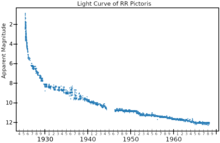
Pictor is a constellation in the Southern Celestial Hemisphere, located between the star Canopus and the Large Magellanic Cloud. Its name is Latin for painter, and is an abbreviation of the older name Equuleus Pictoris. Normally represented as an easel, Pictor was named by Abbé Nicolas-Louis de Lacaille in the 18th century. The constellation's brightest star is Alpha Pictoris, a white main-sequence star around 97 light-years away from Earth. Pictor also hosts RR Pictoris, a cataclysmic variable star system that flared up as a nova, reaching apparent (visual) magnitude 1.2 in 1925 before fading into obscurity.

V1500 Cygni or Nova Cygni 1975 was a bright nova occurring in 1975 in the constellation Cygnus. It had the second highest intrinsic brightness of any nova of the 20th century, exceeded only by CP Puppis in 1942.

T Coronae Borealis, is a recurring nova in the constellation Corona Borealis. It was first discovered in outburst in 1866 by John Birmingham, although it had been observed earlier as a 10th magnitude star.
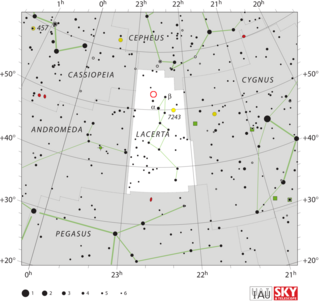
DI Lacertae or Nova Lacertae 1910 was a nova in constellation Lacerta which appeared in 1910. It was discovered by Thomas Henry Espinell Compton Espin at Wolsingham Observatory on 30 Dec 1910, at which time it was an 8th magnitude object. Subsequent examination of pre-discovery photographic plates showed that the outburst occurred sometime between 17 November 1910 and 23 November 1910. It reached a peak brightness of magnitude 4.6 on 26 November 1910, making it visible to the naked eye. Before the nova event DI Lacertae was a 14th magnitude star, and by 1950 it had returned to 14th magnitude.

CP Lacertae was a nova, which lit up on June 18, 1936 in the constellation Lacerta. It was discovered independently by several observers including Leslie Peltier in the US, E. Loreta in Italy, and Kazuaki Gomi, a Japanese barber who discovered the nova during the 19 June 1936 total solar eclipse.

BT Monocerotis was a nova, which lit up in the constellation Monoceros in 1939. It was discovered on a spectral plate by Fred L. Whipple on December 23, 1939. BT Monocerotis is believed to have reached mag 4.5, which would have made it visible to the naked eye, but that value is an extrapolation; the nova was not observed at peak brightness Its brightness decreased after the outbreak by 3 magnitudes in 182 days, making it a "slow nova". The light curve for the eruption had a long plateau period.

V604 Aquilae or Nova Aquilae 1905 is a nova which was first observed in the constellation Aquila in 1905 with a maximum brightness of magnitude 7.6. It was never bright enough to be seen with the naked eye. It was discovered by Williamina Fleming on a Harvard College Observatory photographic plate taken on August 31, 1905. Examination of plates taken earlier indicates that peak brightness occurred in mid-August 1905. The star's quiescent visual band brightness is 19.6.

NQ Vulpeculae also known as Nova Vulpeculae 1976, was a nova that appeared in the constellation Vulpecula in 1976. It was discovered visually at 18:20 UT on October 21, 1976 by English amateur astronomer George Alcock. Its apparent magnitude at the time of discovery was 6.5 It reached its maximum brightness of magnitude 6.0 thirteen days after its discovery, at which point it may have been faintly visible to the naked eye. A few days after maximum brightness, it had faded to magnitude 8.3.

V1059 Sagittarii was a nova, which lit up in 1898 in the constellation Sagittarius. The star reached apparent magnitude 4.5, making it easily visible to the naked eye. It was discovered on 8 March 1898, by Williamina Fleming on a photographic plate taken at the Harvard College Observatory. The discovery plate was an objective prism plate, part of the Henry Draper Memorial Photographs, and Ms Fleming identified it as a nova based on its spectral characteristics.

RW Ursae Minoris is a cataclysmic variable star system that flared up as a nova in the constellation Ursa Minor in 1956.
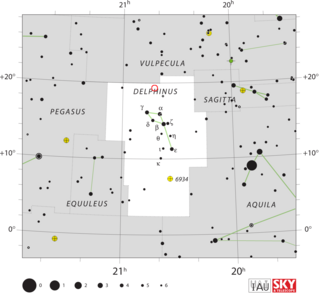
HR Delphini, also known as Nova Delphini 1967, was a nova which appeared in the constellation Delphinus in 1967. It was discovered by George Alcock at 22:35 UT on 8 July 1967, after searching the sky for over 800 hours with binoculars. At the time of discovery it had an apparent magnitude of 5.0. It reached a peak brightness of magnitude 3.5 on 13 December 1967, making it easily visible to the naked eye around that time. Pre-outburst photographs taken with the Samuel Oschin telescope showed it as a ~12th magnitude star which might have been variable.

V1017 Sagittarii is a cataclysmic variable star system in the constellation Sagittarius. It first erupted in 1919, reaching magnitude 7. Its other eruptions in 1901, 1973 and 1991 only reached magnitude 10, leading it to be reclassified from a recurrent nova to a dwarf nova.
SW Sextantis variable stars are a kind of cataclysmic variable star; they are double-star systems in which there is mass transfer from a red dwarf to a white dwarf forming a stable accretion disc around the latter. Unlike other non-magnetic cataclysmic variables, the emission lines from hydrogen and helium are not doubled, except briefly near phase 0.5.
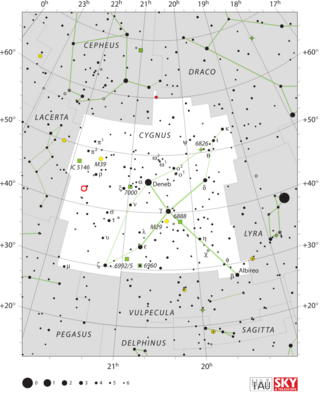
Q Cygni, is a star located in the constellation Cygnus. It is also known as Nova Cygni 1876, and has the designation NGC 7114, and HR 8296. Nova Cygni is located in the northwestern portion of Cygnus along the border with Lacerta.

LL Andromedae is a dwarf nova in the constellation Andromeda, discovered during an outburst in 1979. Its typical apparent visual magnitude is 19.4, but undergoes outbursts events when can reach a peak magnitude of 14.3. Since this magnitude is reached during the most powerful outbursts, while less bright outbursts can occur, it is classified as a SU Ursae Majoris variable.
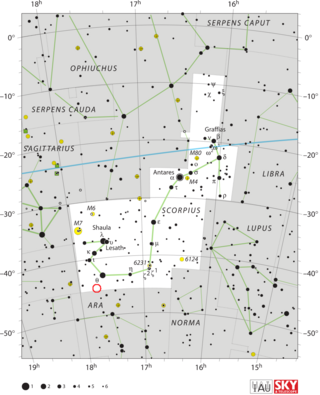
V728 Scorpii, also known as Nova Scorpii 1862, was a nova that occurred in the constellation of Scorpius. It was discovered on 4 October 1862 by John Tebbutt, an astronomer living in New South Wales, Australia, while he was observing a comet. He reported that the star was in the constellation Ara. At the time of its discovery, the nova had an apparent magnitude of 5, making it visible to the unaided eye. Nine days later it had faded to below 11th magnitude, indicating that it was a very fast nova.
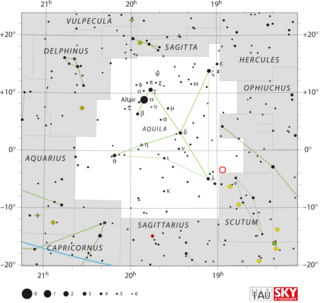
EL Aquilae, also known as Nova Aquilae 1927 was a nova that appeared in 1927. It was discovered by Max Wolf on photographic plates taken at Heidelberg Observatory on 30 and 31 July 1927 when it had a photographic magnitude of 9. Subsequent searches of plates taken at the Harvard College Observatory showed the nova was fainter than magnitude 11.1 on 8 June 1927 and had flared to magnitude 6.4 on 15 June 1927. It declined from peak brightness at an average rate of 0.105 magnitudes per day, making it a fast nova, and ultimately dimmed to about magnitude 21. The 14.5 magnitude change from peak brightness to quiescence was unusually large for a nova.

WY Sagittae, also known as Nova Sagittae 1783, is a star in the constellation Sagitta which had a nova eruption visible in 1783. It was discovered on 26 July 1783 by the French astronomer Joseph Lepaute D'Agelet. It is usually difficult to precisely identify novae that were discovered hundreds of years ago, because the positions were often vaguely reported and historically there was not a clear distinction drawn between different sorts of transient astronomical events such as novae and comet apparitions. However D'Agelet observed this nova with a mural quadrant, which produced coordinates accurate enough to allow modern astronomers to identify the star. D'Agelet reported the apparent magnitude of the star as 6, but Benjamin Apthorp Gould, who analysed D'Agelet's records, determined that what D'Agelet called magnitude 6 corresponds to magnitude 5.4 ± 0.4 on the modern magnitude scale, so the nova was visible to the naked eye.

SW Ursae Majoris is a cataclysmic binary star system in the northern circumpolar constellation of Ursa Major, abbreviated SW UMa. During quiescence it has an apparent visual magnitude of 16.5–17, which is too faint to be visible to the naked eye. Based on parallax measurements, it is located at a distance of approximately 526 light years from the Sun.

ER Ursae Majoris is a variable star in the northern circumpolar constellation of Ursa Major, abbreviated ER UMa. It is a prototype system for a subclass of SU Ursae Majoris dwarf novae. The system ranges in brightness from a peak apparent visual magnitude of 12.4 down to 15.2, which is too faint to be visible to the naked eye. The distance to this system, based on parallax measurements, is approximately 1,163 light years.
